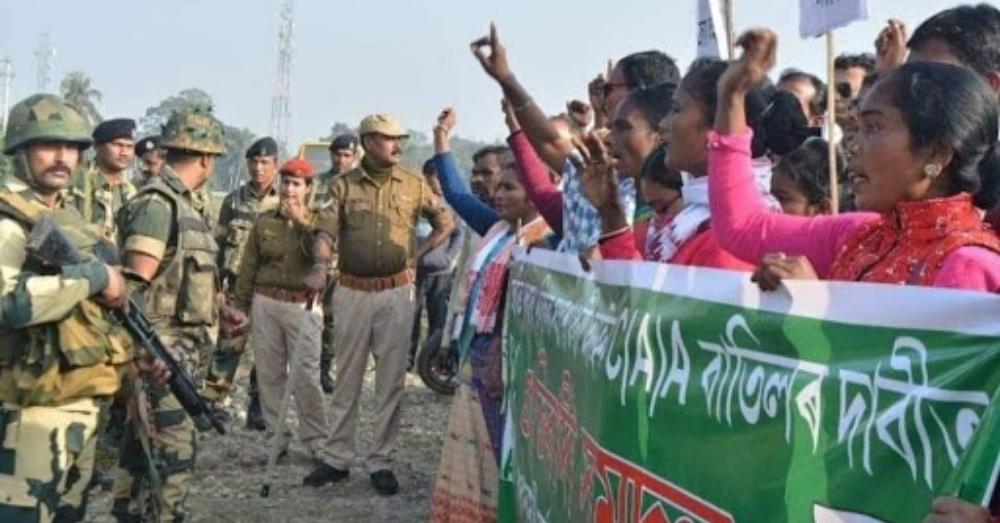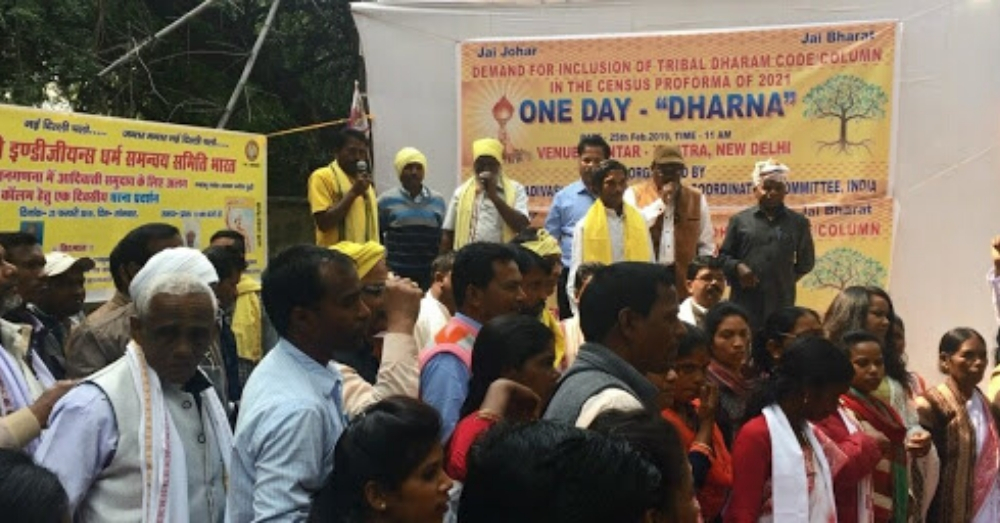The anti-CAA protests bring Adivasis into focus, the Act threatens their identity
Whether in showing paperwork or proving their identity, the Citizenship Amendment Act is going to hit the Adivasis hard. This Act will make it difficult for them to establish their identity


As per the Tribal Affairs Ministry, the forest rights applications of 1.19 million tribals got rejected that had been filled following the Supreme Court orders. Implementing the Forest Rights Act 2006, the court had in February 2019, ordered the Adivasis to prove their ground rights, failing which they may be removed from the forests.
Although the court had stayed the order in September 2019, the Adivasis yet again face the challenge, more daunting this time, of proving their identity and rights as demanded by the Citizenship Amendment Act (CAA) and National Register of Citizens (NRC).
The country witnessed a widespread protest against the implementation of CAA. Beginning with Assam, the protests soon took over the entire nation. The Act met with nationwide resistance as it was generally believed to be an islamophobic ordinance. Endangering secularism in the country, the Act also has put tribals in jeopardy.
The Assam protests, however, took place for a totally different reason – people in Assam fear the threat to Assam’s demography due to the excessive influx of Bangladeshi refugees.
The Act states that the Citizenship Amendment Act shall not be applicable to the scheduled states of Assam, Meghalaya, Manipur and Tripura, but it would be difficult to restrict people’s entry to the scheduled states. Once outsiders enter the states, it becomes even more problematic to regulate their activities.
Assam shares its boundary with six other states, so if refugees are brought to Assam through CAA, they may enter other states too. Also, once regularized, it won’t be difficult for the refugees to infiltrate to other scheduled states.
Due to the huge population of Bengali Hindus, there is a grave danger of the Adivasi cultural, religious and language diversity becoming marginalized, yet again.

CAA and NRC
The Citizenship Act provides Indian citizenship to Hindus, Sikhs, Christians, Jains, Buddhists and Parsis from Afghanistan, Bangladesh and Pakistan. The cut-off date for this is December 2014, which would bring far too many people under the citizenship umbrella.
As per the government estimates, close to 50,000 people would be regularized as per the Act in Assam whereas the real figure exceeds a crore. The assimilation of such a large number of people would bring about a radical change in northeastern India’s demographics.
Adivasi community forms 8% of Indian population and 90% of Arunachal Pradesh, Meghalaya and Manipur’s population. The assimilation of non-Adivasis in these states would adversely affect their Adivasi population.
Adverse effect upon Adivasis of the states
At the time of NRC, about one lakh adivasi citizens’ name did not feature on the list. If this is implemented throughout the country, most of the adivasis would not be able to prove their identity due to a lack of documentation.
Secondly, CAA cannot be viewed in isolation from NRC as they both are two sides of a coin. As per NRC, only those people whose names feature in the Indian citizenship register would be considered Indian citizens.
To become a citizen, it is mandatory for a person or his parents to be born in India before 1971. The citizenship registry missed many names, including that of Hindus. The RSS had shown its discontent on the matter. Experts believe that CAA was implemented to provide citizenship to these Hindus with the Hindu religion as its key aspect.

It has always been challenging for the Adivasis to prove their identities
Adivasis live under the constant threat of ouster from their forest dwellings. Only documentation can protect them against losing it by establishing their ground rights. But now, such applications from lakhs of Adivasis have been dismissed.
The reason? Most of them did not have supporting documents and those who did were still rejected due to faulty documentation. There were several applicants whose claim was overlooked despite their possession of landholdings.
The Adivasis would have to, yet again, show their identity proof for they are not a part of mainstream society. It is obvious that in such a case, they would hardly have the supporting documents to prove them, and their ancestors as Indians.
Besides, the official procedures have always been challenging for the illiterate, poor and powerless. In India, the moneyed and powerful influence the government functioning and the poor are at the receiving end. This is proven true right from demonetization to ration scams. So, it is near certain that the action pertaining to CAA and NRC would bring nothing but apathy and further exploitation of the Adivasis.
Establishing religion as a base of citizenship goes against the Adivasis
The government claims that the Hindus, Sikhs, Buddhists, Jains and the Parsis shall be accorded citizenship due to their religious exploitation, but the Act doesn’t anywhere mention the term ‘religious exploitation’. So, it won’t be incorrect to assume that by giving priority to these religions, the government is asserting its preference for citizens belonging to them.
It is a crisis for the Adivasis as they are not believed to follow an organized religion or if they do, the same has not been recognized by the Constitution. The government of majority calling the Adivasis Hindu in the name of ghar wapasi and outfits like the RSS considering the entire nation as Hindu, is also disregarding the true Adivasi religious rituals and traditions. Adivasis are not a part of the mainstream organized religions.
The Indian census has no place for Adivasi religions. Adivasis believe in their religions like Sarna, Gondi, nature worship Athva, but when the government fails to acknowledge their religions, it indicates that they will have to adopt the mainstream religions. The condition of religion on CAA is a problem to the Adivasis as it challenges their very existence.

How would Banjara Adivasis prove their citizenship?
The Balakrishna Renke Commission had in his survey upon the de-notified and Banjara tribes across 11 states found that seven crore Adivasis had absolutely no proof to establish their citizenship. Several tribal organizations have declared CAA and NRC dangerous for the Adivasis, especially Banjaras and the de-notified tribes.
The Imperial British were wary of Banjara tribes as they couldn’t establish control over the latter so they deemed them criminal tribes. Although these were declared ‘de-notified’ post-independence, they still reel under the ‘criminal’ stigma.
Due to this, de-notified tribes such as the Dafirs of Gujarat and Satiyas of Rajasthan are, even today, forced to live devoid of basic facilities like education, employment and shelter as they do not have identity proofs. Madurai’s Bambammatkara and Kurkurupkragal banjara tribes are also looked upon with suspicion because they do not have any government documents.
Several Adivasis are not there in the Sixth Schedule, which guarantees a constitutional proof of Adivasi or indigenous tribe. Bodo, Hujong, Rabha, Jaintiya etc are striving in Meghalaya for establishing their unique identity. So, when it would be their turn to prove their citizenship, they would fail to assert even their own identity in the process.
The Rights and Risk Analysis Group had found in its survey that 25,000 Bodo, 9,000 Riyang, 8,000 Hujong and thousands of Adivasis of other tribes did not find their names mentioned in the NRC of August 31, 2019. It was found that they were deprived of citizenship due to their failure to establish their grounds rights.
It is noteworthy that these tribes undertake shifting agriculture whereby they neither restrict themselves to a place nor establish ownership rights over a piece of land. Similarly, Gujjars and Bakarwal tribes of Jammu and Kashmir that herd goats and sheep, are deprived of their land rights.

Banjara tribes do not possess the ground rights
Tamil Nadu’s Irula tribe was subjected to constant exploitation and its members arrested at the slightest suspicion for any crime without rightful investigation. They cannot seek the support of the SC/ST Prevention of Atrocities Act, 1989 as they are not listed as a scheduled tribe. So, when the CAA and NRC would declare certain people illegal, Banjara tribes are bound to be a part of it.
India is keen to accord Indian citizenship to the refugees from the neighbouring countries, but what about its own displaced citizens? Projects such as Sardar Sarovar Dam and the Statue of Unity in Gujarat have already uprooted crores of Adivasis.
In states such as Jharkhand and Maharashtra, the government has been confiscating the land of Adivasis and displacing lakhs of Adivasis in the process without providing any compensation or rehabilitation. In fact, they have been pushed further to oblivion and poverty.
They are already deprived of education, employment, health and economic institutions. In such a state, this Act will make it even more difficult for the Adivasis to establish their identity and access the basic facilities of ration, water, house, jobs, and education.
When the government fails to provide true citizenship to its own citizens, how can it think of offering the same to people from other countries? If it cannot spare funds for the betterment of its Adivasi minority why does it waste money on such meaningless exercises?
Adivasis against CAA
Adivasis have taken to newer and creative ways to protest against CAA across the country. Opting to elect the JMM (Jharkhand Mukti Morcha) Congress coalition to power in Jharkhand shows the resolve of this tribal state to reject the anti-tribal policies. Numerous Adivasi outfits had organized CAA protest marches in Jharkhand’s Ranchi and Jamshedpur.
Whether in showing paperwork or proving their identity, CAA will hit the Adivasi harder and deeper. Also, it will affect the northeastern India’s tribal culture. While talking for or against CAA or NRC, it would be important to pay heed to its possible effect on the Adivasis as well to address it.
Deepti Mary Minj studied Development and Labour Studies at the Jawaharlal Nehru University
(Views are personal)
This article was first published by Adivasi Lives Matter-Youth Ki Awaaz. You can read the original article here

